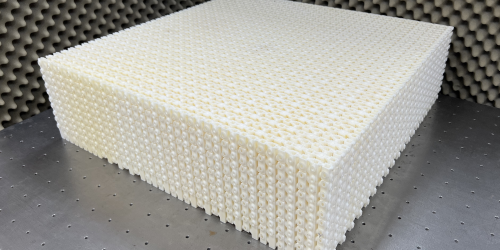Material Hums a New Topological Tune
Topological insulators—which are insulating in their bulk interiors and conducting on their surfaces—are the entry-level topological materials. In recent years, researchers have identified many other topological materials with a variety of boundary states on their surfaces, edges, and corners. Adding to this menagerie of “higher-order” topological phases, Zhengyou Liu of Wuhan University in China and colleagues have now demonstrated a higher-order nodal-line semimetal (NLSM) in an acoustic system [1]. With its unique boundary states, this phononic crystal might spur applications in acoustic sensing and energy harvesting.
Topological semimetals are characterized by closed gaps where two energy bands meet, resulting in exotic electron transport such as high carrier mobility and large magnetoresistance. Physicists represent the bands in these materials as surfaces in energy versus two-dimensional momentum space. In an NLSM, two of these surfaces meet along a line in the bulk and a corresponding boundary state on its surface. NLSMs have been observed in materials and analog systems, but researchers have had a harder time realizing higher-order NLSMs—those with additional boundary states on their edges.
For their phononic crystal, Liu and colleagues used 3D printing to make an array of millimeter-sized cavities and tunnels through which sound waves could travel. The team placed a speaker at different points in the array and measured the sound transmission through the material. From the data, they derived the acoustic band structure, observing nodal lines in the bulk, as well as “drumhead” states on the surfaces and “hinge” states on the edges—as predicted for a higher-order NLSM. The surface and edge states exhibit two features—a high density of states and a slow group velocity—which could be useful for, respectively, detecting sounds and capturing energy at particular frequencies, the team says. The results may also help in the search for higher-order topological phases in solid materials.
–Michael Schirber
Michael Schirber is a Corresponding Editor for Physics Magazine based in Lyon, France.
References
- Q. Ma et al., “Observation of higher-order nodal-line semimetal in phononic crystals,” Phys. Rev. Lett. 132, 066601 (2024).




